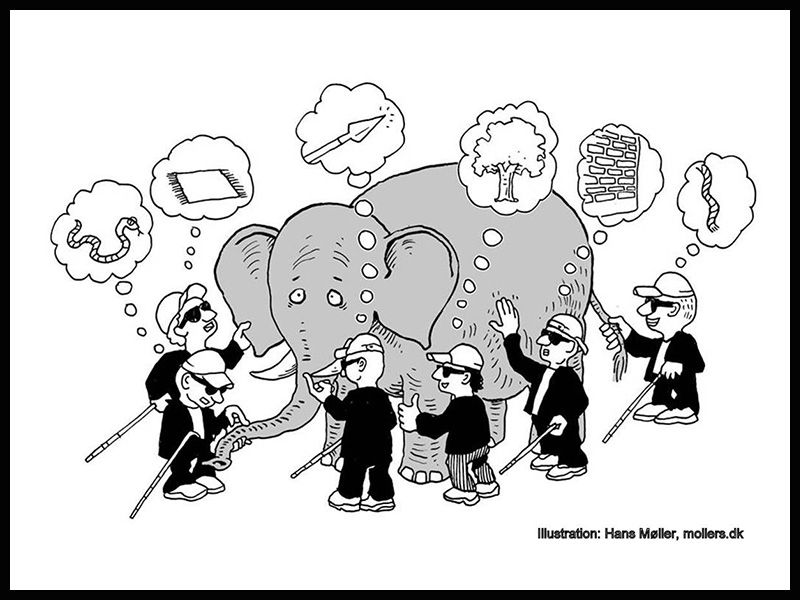
A group of blind people were brought to an animal, which was an elephant. They were not aware of its shape or form and decided to understand it by touch.
So, they each approached the elephant and touched it.
The first person who touched the trunk, says “This creature is like a thick snake.”
The next person whose hand touched the elephant’s ear, says “It seems like a type of fan.”
Then the third who has his hand resting on the elephant leg exclaims “This is a pillar, like a tree trunk.”
With his hand against the thick hide on the elephant’s side, the fourth blind man says “This is a wall.
The fifth who felt its tail describes it as a rope to the rest.
The last touches its tusk and declares, “This is hard and smooth, like a spear.”
Each blind person had a mental image of what they thought an elephant was like. Had they decided to piece their understanding together, they might have gotten a better idea of what an elephant actually looked like.
This example demonstrates the power and value of interconnected knowledge.
Leveraging Interconnected Knowledge
Simply remembering isolated facts and then trying to fit them back bit by bit does not help your understanding. It may have gotten you through high school, but it quickly falls apart in real life.
As mixed martial artists, we do not isolate ourselves into discrete disciplines. We only break down moves that way because it makes it much easier to study.
Once you’ve learned new moves, you’ll need to reintegrate them back into the complex situations in which they can occur, like a match for instance.
There are several things happening at once in an MMA fight. Whether it’s grappling or stand-up, your actions are simultaneous and connected to each other.
A single punch by itself won’t do much.
Throwing a jab should mean setting up a cross, using a cross to set up a hook, etc. You’re always mixing things up in power, tempo, and speed.
Knowing this reduces the blind spots that restrict your view to only focus on the problem in front of you. Employing second and third-order thinking to devise solutions requires you to draw on multidisciplinary knowledge.
In mixed martial arts, you’d have to diagnose and interpret your opponent’s intentions and objectives. What were their combinations? Should you telegraph a punch and shoot for the takedown?
Using Mental Models to Reduce Blind Spots
The knowledge and skills acquired from other disciplines form a series of data points that connect to and reinforce each other.
This framework of thinking is an example of a mental model. Mental models are critical in helping us perceive and respond to events.
As you use different mental models to process problems, you actively remove the blind spots. This helps you gain a better overall understanding of the scope of what it is you’re dealing with.
Like the parable of the blind group and the elephant, mixed martial artists are most efficient if they can draw and apply practical knowledge from a variety of combat disciplines.
In mixed martial arts, you know the rules. What’s permitted and what isn’t. That helps you operate within the boundaries and plot what is the best course of action you and your opponent might take.
Practicing to Strengthen Your Mental Frameworks
There are many reasons for a dedicated fight camp but all of them are geared to prepare you for your immediate opponent.
Situational drills are very common in fight camps and your coaches are simulating disadvantageous scenarios to train your responses and reflexes for match day.
Practice sessions serve as repetitive events that help your brain process and store similar data points. These points make up the mental framework that you use during the match.
As you continually strengthen your framework through training and fight camps, it will aid your decision making in the fight.
Reduce not avoid
Blind spots will always exist. They are not something we can always actively avoid, even with the best mental frameworks and models in place.
The best fighters who win usually have the mental processing ability to determine their game plan. In addition, they can execute this game plan using their arsenal of moves.
Mental models and frameworks sound abstract but they are actually very fundamental to the way we’ve always responded to events around us.
However, being conscious of the role they play in your preparation as an MMA fighter can be useful.
If you aim to grow as a mixed martial artist and a person, you’ll find the lessons from this article useful in helping you to reduce the blind spots and mistakes you may make in your life decisions.
